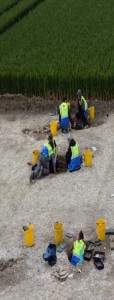Today is the first day of the second week; the students and volunteers began the day with a site briefing from Miles Russell and Paul Cheetham about what they believe the site be about. It’s important that site briefings take place on site to ensure that the students and volunteers understand what they are excavating and how it might affect the results of the site.
Trench D is believed to be the southern end of last year’s site, as it shows no evidence of a boundary; so it is an open site not a hillfort. The main question on this Trench is whether it is Early Iron Age or Later Iron Age. The shape of Trench D is very odd, due to being in the shape of a T, this was due to the geophysics getting a lot of signal from the western side. Most of the features in the Trench are being shown to be Iron age but the ditches have been seen to be Early and Late Roman. In the western side of the Trench there is evidence of a corn drier and also a bronze age
pit which is unusual because this would date 2000 years before the Roman period. Mostly it is pottery being obtained from the Trench which is good because these can be used to date the site. Some aspects of the finds are showing to be sub-roman which is also known as the dark era. These time period was known as the dark era was due to no literature being available. There is also very limited archaeological evidence and most people in that era were still farming and growing their crops to eat. Romans were seen to have obsessive compulsive disorder, so everything was very neat and most buildings were square in shape. It is believed that on site there might be sunken features like houses but this will not be proven until the features have been excavated.
Trench E has visible evidence of 2 (possibly 3) roundhouses which shows that the Trench is most likely Iron Age. Due to ploughing and the removal of top soil has removed most evidence of postholes. The roundhouses can defiantly be seen as Iron Age however the features around might not be, so there is little chance that they are connected. The gullies which have been found are less distinctive so it is harder to work out what era they are from. Only one half of Trench E is being dug at the moment but hopefully by the end of this week the students and volunteers will be digging the other half.
